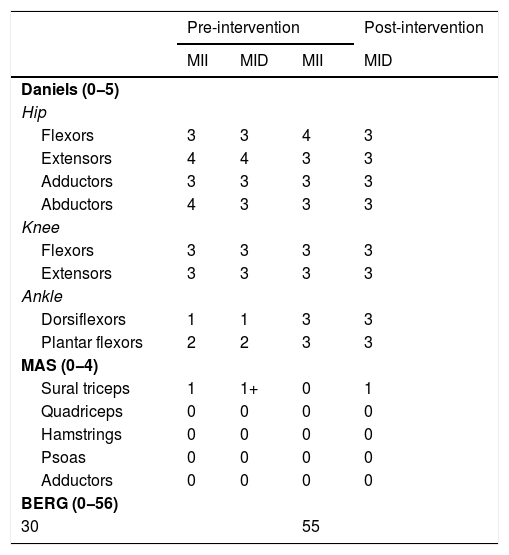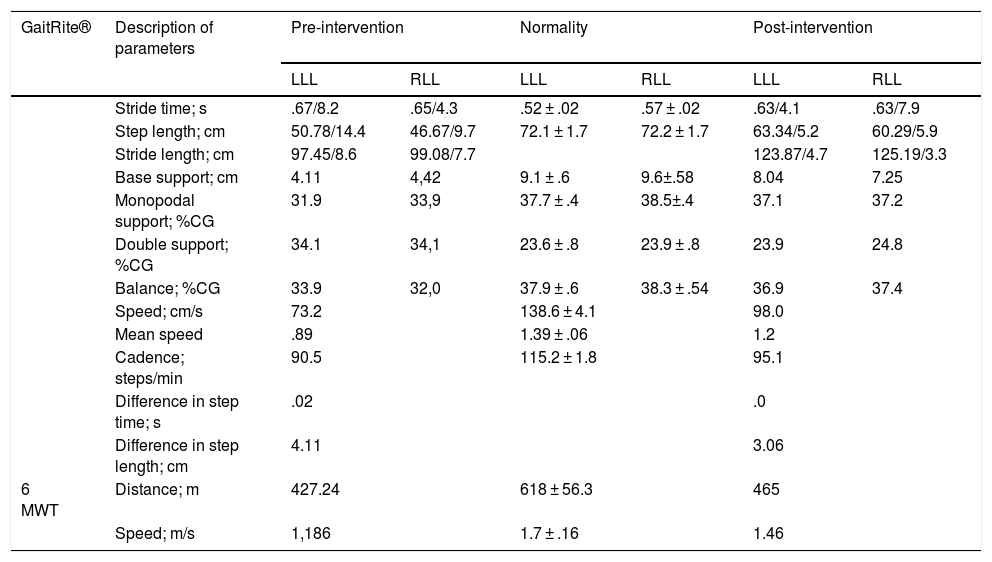Gait disturbance is one of the most common impairments in multiple sclerosis (MS). Combined with conventional physiotherapy (CP), dance as a therapeutic intervention has shown its functional benefits in other neurological diseases, such as Parkinson disease.
GoalsTo determine gait dysfunction in a patient, to implement and carry out a physiotherapy and dance intervention programme and assess the results with a gait analysis platform.
Subject and methodsEvaluation pre and post intervention of the following variables: range of motion (goniometry), muscle strength (Daniel’s scale), spasticity (Modified Ashworth scale), balance (Berg balance scale (BBS)) and spatio-temporal gait patterns (GaitRite®); intervention of 15 one-hour sessions (3 weeks) combining CP and Spanish Dance (SD) in a 49-year-old woman with a relapsing-remitting MS diagnosis.
GoalsTo determine gait dysfunctions in this patient, to implement and carry out a physiotherapy and dance intervention programme and assess the results with a gait analysis platform.
ResultsThe spasticity decreased and the strength of the ankle in flexors and extensors increased. The balance and impaired spatio-temporal parameters of gait improved significantly (an increase of gait velocity, step length and monopodal support phase and increase of 25 points on the BBS).
ConclusionGait disturbance consistent with data from previous research was found and significant improvements have been achieved thanks to the intervention performed. SD has proved to have the necessary tools to achieve the benefits obtained with other dance modalities in neurodegenerative diseases and it may be compatible with CP treatment.
Una de las alteraciones más comunes en la esclerosis múltiple (EM) es la disfunción de la marcha. Además de la Fisioterapia convencional (FC), la danza como intervención terapéutica ha demostrado sus beneficios funcionales en otras enfermedades neurológicas como la enfermedad de Parkinson.
ObjetivosAnalizar las alteraciones de la marcha en una paciente, implementar y ejecutar un programa de intervención de Fisioterapia y danza en base a los déficits observados y objetivar los resultados a través de un dispositivo de análisis de la marcha.
Sujeto y métodosEvaluación pre y post intervención las siguientes variables: rango articular (goniometría), fuerza muscular (escala de Daniels), espasticidad (escala de Ashworth modificada), equilibrio (escala de equilibrio de Berg (EEB) y parámetros espacio-temporales (PETM) de la marcha (GaitRite®); intervención de una duración de 15 sesiones de 1 hora, durante 3 semanas, combinando FC y danza española (DE) en una mujer de 49 años diagnosticada de EM remitente recurrente.
ResultadosDisminuyó la espasticidad y aumentó la fuerza en los flexores dorsales y plantares de tobillo, mejoró el equilibrio (25 puntos más en EEB) y los PETM alterados (aumento de la velocidad de la marcha, longitud del paso y fase de apoyo monopodal).
ConclusiónSe encontraron alteraciones de la marcha en consonancia con lo reportado en bibliografía, las cuales obtuvieron una mejoría tras la intervención combinada realizada. La DE ha mostrado tener las herramientas necesarias para conseguir los beneficios obtenidos con otras modalidades de danza en enfermedades neurodegenerativas, que pueden ser compatibles con el tratamiento de FC.







